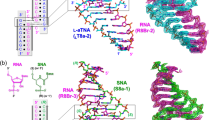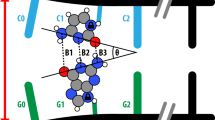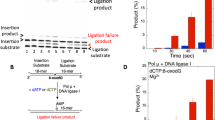Abstract
BEFORE it can exert its mutagenic and carcinogenic activities1,2 benzo(a)pyrene (BP) requires metabolic activation and it is widely considered3–5 that the initiating event in these processes is covalent binding to DNA. The predominant form of the activated hydrocarbon is a diol epoxide6–11, of which four possible isomers are (+) and (−) enantiomers of 7β,8α-dihydroxy-9α-10α-epoxy-7,8,9,10-tetrahydro-BP (anti-BP diol epoxide) and (+) and (−) enantiomers of 7β,8α-dihydroxy-9β,10β-epoxy-7,8,9,10-tetrahydro-BP (syn-BP diol epoxide). Enzymatic formation of the (+) anti and (+) syn configurations have been reported elsewhere12,13. We have shown that the racemic (±) anti-BP diol epoxide forms two stable covalent adducts each with the exocyclic amino groups of deoxyguanosine, deoxyadenosine and probably deoxycytidine14. We report here that we have now resolved the enantiomers of (±) anti-BP diol epoxide and reacted the optically pure hydrocarbons with DNA. Each enantiomer reacts with the exocyclic amino group of deoxyguanosine to form a pair of diasteriomers in a ratio which depends on the secondary structure of the nucleic acid. The (+) enantiomer reacts preferentially or asymmetrically with deoxyguanosine in double stranded DNA but the two enantiomers react equally with the same position in single-stranded DNA. The basis for the stereoselective binding is unknown but may involve formation of sterically orientated physical complexes before covalent attachment of the hydrocarbon to DNA. The mode of binding in the deoxyadenosine sites, on the other hand, must be different, as the (+) and (−) enantiomers react equally in either single- or double-stranded DNA.
This is a preview of subscription content, access via your institution
Access options
Subscribe to this journal
Receive 51 print issues and online access
$199.00 per year
only $3.90 per issue
Buy this article
- Purchase on Springer Link
- Instant access to full article PDF
Prices may be subject to local taxes which are calculated during checkout
Similar content being viewed by others
References
Miller, E. C. & Miller, J. A. in Molecular Biology of Cancer (ed. Bush, H.) 377 (Academic, New York, 1973).
Heidelberger, C. A. Rev. Biochem. 44, 79–121 (1975).
Brookes, P. & Lawley, P. D. Nature 202, 781–784 (1964).
Ames, B. N., Sims, P. & Grover, P. L. Science 176, 47–49 (1972).
McCann, J., Choi, E., Yamasaki, E. & Ames, B. N. Proc. natn. Acad. Sci. U.S.A. 72, 5135–5139 (1975).
Sims, P., Grover, P. L., Swaisland, A., Pal, K. & Hewer, A. Nature 252, 326–328 (1974).
Huberman, E., Sachs, L., Yang, S. K. & Gelboin, H. V. Proc. natn. Acad. Sci. U.S.A. 73, 607–611 (1976).
Meehan, T., Straub, K. & Calvin, M. Proc. natn. Acad. Sci. U.S.A. 73, 1437–1441 (1976).
Weinstein, I. B. et al. Science 193, 592–595 (1976).
Koreeda, M., Moore, P. D., Yagi, H., Yeh, H. J. & Jerina, D. M. J. Am. chem. Soc. 98, 6720–6722 (1976).
King, H. W., Osborne, M. R., Beland, F. A., Harvey, R. G. & Brooks, P. Proc. natn. Acad. Sci. U.S.A. 73, 2679–2681 (1976).
Yang, S. K., McCourt, D. W., Roller, P. P. & Gelboin, H. V. Proc. natn. Acad. Sci. U.S.A. 73, 2594–2598 (1976).
Koreeda, M. et al. Science 199, 779–781 (1978).
Meehan, T., Straub, K. & Calvin, M. Nature 269, 725–727 (1977).
McCaustland, D. J. & Engle, J. F. Tetrahedron Lett. 30, 2549–2552 (1975).
Yagi, H., Hernandez, O. & Jerina, D. M. J. Am. chem. Soc. 97, 6881–6883 (1975).
McCaustland, D. J., Fisher, D. L., Duncan, W. P., Ogilivie, E. J. & Engle, J. F. J. Labelled Compounds 12, 583–589 (1975).
Yang, S. K. et al. Analyt. Biochem. 78, 520–526 (1977).
Straub, K. & Meehan, T. (in preparation).
Beland, F. A. & Harvey, R. G. JCS chem. Commun., 84–85 (1976).
Nakanishi, K. et al. J. Am. chem. Soc. 99, 258–260 (1977).
Yagi, H., Akagi, H., Thakker, D. R., Mah, H. D., Koreeda, M. & Jerina, D. M. J. Am. chem. Soc. 99, 2358–2359 (1977).
Ivanovic, V., Geacintov, N. E., Yamasaki, H. & Weinstein, I. B. Biochemistry 17, 1597–1603 (1978).
Lesko, S. A., Hoffman, H. D., Ts'o, P. O. & Maher, V. M. in Progress in Molecular and Subcellular Biology, Vol. 2, (ed. Hahn, F. E.) 347–370 (Springer, Berlin, 1971).
Müller, W. & Crothers, D. M. Eur. J. Biochem. 54, 267–277 (1975).
Wood, A. W. et al. Biochem. biophys. Res. Commun. 77, 1389–1396 (1977).
Lewin, B. Gene Expression, 320–375 (Wiley, London, 1974).
Bueing, M. K. et al. Proc. natn. Acad. Sci., U.S.A. 75, 5358–5361 (1978).
Author information
Authors and Affiliations
Rights and permissions
About this article
Cite this article
MEEHAN, T., STRAUB, K. Double-stranded DNA stereoselectively binds benzo(a)pyrene diol epoxides. Nature 277, 410–412 (1979). https://doi.org/10.1038/277410a0
Received:
Accepted:
Issue Date:
DOI: https://doi.org/10.1038/277410a0
This article is cited by
-
Wavefunction and reactivity study of benzo[a]pyrene diol epoxide and its enantiomeric forms
Structural Chemistry (2014)
-
Sequence specificity of mutations induced by benzo[a]pyrene-7,8-diol-9,10-epoxide at endogenousaprt gene in CHO cells
Somatic Cell and Molecular Genetics (1988)
-
Comparison of DNA adducts in mouse and rat epidermis versus dermis after topical application of (�)r-7,t-8-dihydroxy-t-9,10-oxy-7,8,9,10-tetrahydrobenzo (a)pyrene and (�) benzo(a)pyrene-4,5-oxide
Journal of Cancer Research and Clinical Oncology (1988)
Comments
By submitting a comment you agree to abide by our Terms and Community Guidelines. If you find something abusive or that does not comply with our terms or guidelines please flag it as inappropriate.



